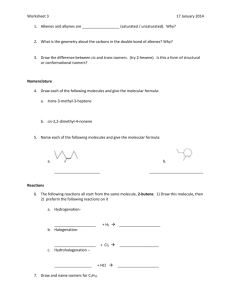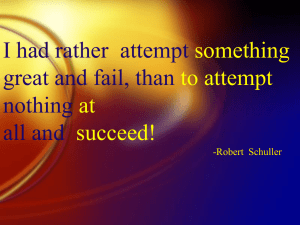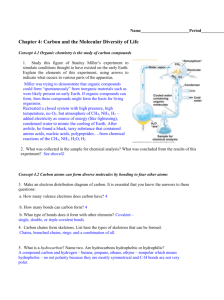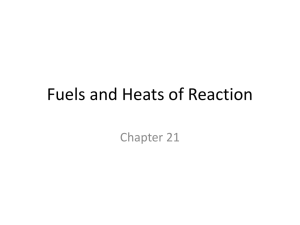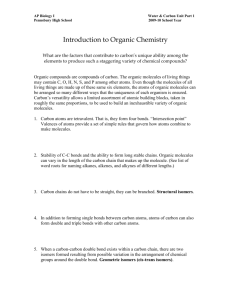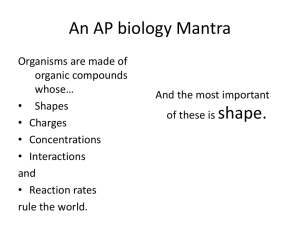Chapter 4
advertisement
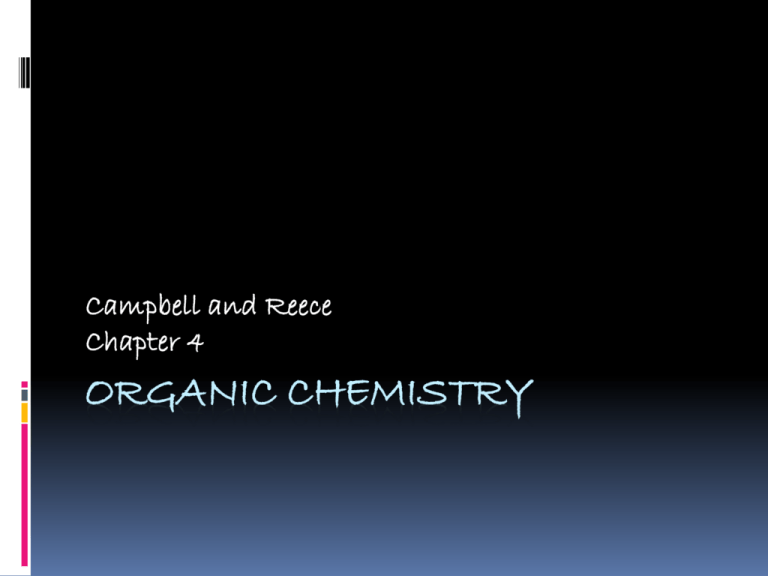
Campbell and Reece Chapter 4 ORGANIC CHEMISTRY Organic Chemistry study of carbon compounds (most also have hydrogen) range from small molecules (methane has 4 atoms) to very large one (proteins can have thousands of atoms) Major Elements of Life Carbon Hydrogen Oxygen Nitrogen Sulfur Phosphorus Carbon is very Versatile because C can form 4 covalent bonds these 6 elements can form an almost limitless # organic molecules VITALISM Some credit Hippocrates Simply stated: there is a life force outside physical & chemical laws Jons Jakob Berzelius Swedish chemist in early 1800’s “Organic compounds come from living things” (only ) so inorganic compounds found only in nonliving things Fredrich WÖhler German chemist 1828: synthesized urea in lab (normally made in kidney) Did not convince Vitalists because he 1 reactant he used came from animal blood Urea Hermann Kolbe Student of Wohler Synthesized urea using only inorganic reactants….. Crushed Vitalism…..sorry Yoda Origin of Life on Earth Stanley Miller, 1953 Designed experiment trying to re- create conditions on early Earth Hypothesized : abiotic synthesis of organic compounds possible Miller’s Experiment Closed system Flask of water (early seas) heated Water vapor rose to another higher chamber containing “atmosphere” Sparks added (lightening) “rain” formed, cooled material collected analyzed Miller’s Experiment Miller’s Conclusion Complex organic compounds could form spontaneously under conditions thought to exist on early Earth Miller’s Results 2008: re-analyzed some samples from Miller’s experiments in the 1950’s Additional organic compounds identified Organic Chemistry Definition changed to: Study of Carbon Compounds (regardless of origin) Bonding with Carbon C has 4 valence e Bonds possible: 4 single covalent bonds 2 single & 1 double covalent bond 2 double covalent bonds 1 single & 1 triple covalent bond Bonding with Carbon Carbon Skeletons Carbon chains form the backbone of most organic molecules These skeletons can be Straight Branched Carbon Skeleton Variation In rings: Carbon Skeleton Variation 1 important source of molecular complexity & diversity that characterizes living organisms Hydrocarbons C&H Major components of petroleum products (fossil fuels) When organism dies all water soluble compounds wash away as it decays. Fats stay behind hydrocarbons Burn fossil fuels because they release a large amount of energy Fossil Fuels Isomers Cpds with same # and types of atoms but they are arranged differently Different structures behave differently 3 types: 1. Structural Isomers 2. Cis/trans Isomers 3. enantiomers Structural Isomers Differ in covalent arrangements of their atoms Molecular formula same, structure different Structural Isomers # possibilities for different arrangements of atoms increases dramatically as carbon skeleton increases in size Cis-trans Isomers aka geometric isomers Carbons have covalent bonds with same atoms but these atoms differ in their spatial relationship Cis-trans Isomers In cis groups are on same side of Carbon In trans groups are across from each other Cis-trans Isomers The difference in cis-trans can dramatically affect the biological behavior of the molecule Enantiomers Isomers that are mirror images of each other Differ in shape due to having asymmetric carbon Enantiomers Usually only 1 is biologically active Other 1 may have much milder effect Functional Groups Portion of molecule that participates in chemical reactions in a characteristic way 7 common, & very important functional groups in organic chemistry HYDROXYL -OH Make alcohols Properties: 1. Polar 2. Can for H-Bonds with water (help cpd dissolve in water) CARBONYL -C=O Makes: 1. Ketones: if in middle of molecule 2. Aldehyde: if at end of molecule Properties: 1. can be isomers 2. ketoses/aldoses CARBOXYL -COOH Makes: organic acids Properties: 1. Can donate H+ COO2. Mostly found in cells in ionized form (charge of -1) & called a carboxylate ion 3. In amino acids CARBOXYL AMINO -NH2 Makes: Amines Properties: 1. Acts as a base (can take H+) 2. Found in cells in ionized form with +1 charge 3. in amino acids AMINE SULFHYDRYL -SH Makes: thiols Properties: 1. 2 –SH can react forming disulfide bridges These bridges make hair curly PHOSPHATE -PO4 Structure: 2 O have (-) charge Makes: Organic phosphates Properties: Makes molecule polar (-1) charge when in middle, (-2) when on end Can react with water energy PHOSPHATE METHYL -CH3 Makes: Methylated compounds Properties: When attached to DNA, affects expression of genes Attachment to Testosterone changes biological effect compared to Estrogen (without methyl group) METHYL ADENOSINE TRIPHOSPHATE ATP Made of adenosine + 3 phosphate groups When 3 phosphates in series, easy to remove 3rd group with water Hydrolysis of ATP
